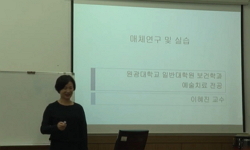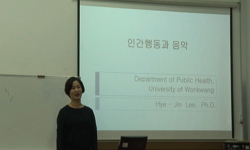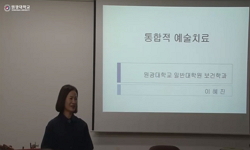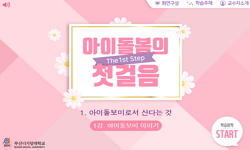본 연구의 목적은 타악기 중심의 교정음악치료 프로그램이 교도소에 수감 중인 재소자의 자아존중감과 부정적 정서 변화에 미치는 효과와 참여자가 인식한 만족도 요인을 살펴봄으로써 교...
http://chineseinput.net/에서 pinyin(병음)방식으로 중국어를 변환할 수 있습니다.
변환된 중국어를 복사하여 사용하시면 됩니다.
- 中文 을 입력하시려면 zhongwen을 입력하시고 space를누르시면됩니다.
- 北京 을 입력하시려면 beijing을 입력하시고 space를 누르시면 됩니다.
교정음악치료가 재소자의 자아존중감 및 부정적 정서변화에 미치는 효과: 타악기를 중심으로 = The Effect of Correctional Music Therapy on the Chnages Self-Esteem And Negative Emotion of Prison Inmates : Based on Percussion
한글로보기https://www.riss.kr/link?id=T13741963
- 저자
-
발행사항
성남: 가천대학교 특수치료대학원, 2015
-
학위논문사항
학위논문(석사) -- 가천대학교 특수치료대학원 , 특수치료학과 음악치료학 전공 , 2015. 02
-
발행연도
2015
-
작성언어
한국어
- 주제어
-
DDC
615.85154
-
발행국(도시)
경기도
-
형태사항
108p; 26 cm.
-
일반주기명
지도교수: 이인용
- 소장기관
-
0
상세조회 -
0
다운로드
부가정보
국문 초록 (Abstract)
본 연구의 목적은 타악기 중심의 교정음악치료 프로그램이 교도소에 수감 중인 재소자의 자아존중감과 부정적 정서 변화에 미치는 효과와 참여자가 인식한 만족도 요인을 살펴봄으로써 교정 심리치료 현장에서 적용 가능한 음악치료의 효과와 강점을 제시하는 것이다.
이를 위해 경기도 Y시 소재 S교도소에서 집중인성교육에 참여하는 재소자 14명을 대상으로 주1회, 100분간 8회기의 교정음악치료 프로그램을 실시하였다. 효과 검증을 위해 자아존중감 검사(SEI)와 다면적 형용사 체크리스트(MAACL)로 사전 ․ 사후 검사를 실시하여 측정된 결과를 대응표본 t 검증으로 비교 분석하였다. 참여자들이 경험한 프로그램의 만족도 요인을 알아보기 위해 연구자가 구성한 Likert 5점 척도의 사후 질문지 결과를 빈도 분석하였다.
본 연구의 결과는 다음과 같다. 첫째, 교정음악치료 프로그램 실시 사전 ․ 사후에 측정한 대상자들의 자아존중감 점수는 평균 3.59점에서 3.72점으로 향상 되었으며, 자아존중감의 하위 요인 중 자기주장과 확신 요인에서 통계적으로 유의미한 효과가 있었다(t= -1.442, p<.05).
둘째, 교정음악치료 프로그램 실시 사전 ․ 사후에 측정한 대상자들의 MAACL 점수는 평균 15.43점에서 12.36점으로 감소하였으며, MAACL 하위 요인 중 불안 요인에서 통계적으로 유의미한 효과가 있었다(t=3.539, p<.01).
셋째, 연구참여자들의 만족도가 가장 높았던 회기 주제는 ‘행복’(92.8%)으로 나타났다. 타악기 활동 유형 중 즉흥 연주(78.6%)에 대한 만족도가 가장 높았으며, 효과음 악기(92.9%)와 북(78.6%)에 대한 악기 만족도가 가장 높았다. 음악치료 활동 중에는 팀 별 공연(85.7%)과 타악기 연주(78.6%)에 가장 만족한 것으로 나타났다. 추천 여부에 대해 참여자의 92.9%가 ‘추천할 것이다’라고 응답하여 높은 만족도를 보였으나, 프로그램 횟수에 대해 85.8%가 불만족하여 8회기 이상의 장기적인 프로그램을 희망하였다. 참여자들은 음악치료 프로그램이 감정 표현을 통한 긍정적 정서 경험 및 스트레스 해소, 낯선 상황에 대한 두려움 극복, 동료와의 관계 개선, 수감 생활 및 출소 이후의 삶에 대한 계획 설계 등에 유익하였다고 진술하였다.
본 연구는 교도소 재소자를 대상으로 음악치료 프로그램을 구성하고 시행하여 음악치료가 통제된 교도소 환경에서 제한되기 쉬운 재소자의 자기 표현 과 건강한 대인 교류 경험을 제공하여 재소자의 중요한 재범 요인인 자아존중감과 부정적 정서 변화에 긍정적인 효과를 미칠 수 있다는 것을 확인하였다. 이에 교정음악치료가 재소자의 정서 변화와 행동 수정을 위한 효과적인 치료적 접근으로 활용될 수 있음을 제언한다.
다국어 초록 (Multilingual Abstract)
The purpose of this research is to investigate the effect of music therapy program based on percussion on the changes in self-esteem and negative emotion of prison inmates, and to examine the satisfaction factor of the activity, thereby proposing the ...
The purpose of this research is to investigate the effect of music therapy program based on percussion on the changes in self-esteem and negative emotion of prison inmates, and to examine the satisfaction factor of the activity, thereby proposing the direction and base line data for the future study of correctional music therapy.
To this end, a correctional music therapy program was conducted once a week, 100 minutes each throughout 8 sessions with 14 participants of prison inmates participating in Foster Character education in S prison located in Y city, Gyeonggi-Do.
Self-esteem Inventory(SEI) and Multiple Affect Adjective Check List(MAACL) were carried out as pre and post inspection for effectiveness verification ; measured results were compared and analyzed with bijective sample t-test. In addition, frequency analysis of program satisfaction factors of experienced participants were made through post-survey of 5-point Likert scale designed by the researcher.
The results of this study are as follows : First, self-esteem points of subjects measured in pre and post correctional music therapy program have improved with increased average point from 3.59 to 3.72, and were shown to be statistically significant in self-assertion and confidence—the sub-factors of self-esteem. (p<.05)
Second, Multiple Affect Adjective Checklist points of targets measured in pre and post correctional music therapy program have decreased from average 15.43 to 12.36; fear factor, one of the three sub-factors, was shown to have statistically significant effect. (p<.01)
Third, the most satisfying session theme of Participants was shown to be ‘happinesss’(92.8%). Also, improvisation out of percussion playing activity(Drum circle) type was preferred (78.6%); among musical instruments, sound effects instrument and drum types showed highest satisfaction, each with 92.9% and 78.6%.
This implies that correctional music therapy with group members is effective in inmates’ revealing of their presence, in providing self-confidence and sense of achievement leading to self-esteem improvement including self-assertion and confidence, and in enabling self-expression which is likely to be suppressed in prison environment thereby decreasing fear. Hence, it is proposed that correctional music therapy can be utilized in orthodontic psychology treatment program for emotional purification and social adaptation of prison inmates.
목차 (Table of Contents)
- 목 차
- Ⅰ. 서론 1
- A. 연구의 필요성 및 목적 1
- B. 연구문제 4
- C. 용어의 정의 5
- 목 차
- Ⅰ. 서론 1
- A. 연구의 필요성 및 목적 1
- B. 연구문제 4
- C. 용어의 정의 5
- Ⅱ. 이론적 배경 7
- A. 심리학적 관점에서 본 재소자의 특성 7
- B. 재소자의 자아존중감 및 정서 10
- 1. 재소자의 자아존중감 10
- 2. 재소자의 정서 12
- 3. 재소자의 자아존중감과 정서의 상관관계 13
- C. 교정음악치료 14
- 1. 교정음악치료의 개념 및 강점 14
- 2. 교정음악치료 선행 연구 18
- 3. 타악기 중심의 음악 치료 25
- Ⅲ. 연구방법 28
- A. 연구참여자 28
- B. 측정도구 29
- 1. 자아존중감 척도(SEI) 29
- 2. 다면적 형용사 체크 리스트(MAACL) 30
- 3. 교정음악치료 프로그램 평가 질문지 31
- C. 연구 설계 및 절차 32
- 1. 연구 설계 32
- 2. 연구 기간 및 절차 32
- D. 자료 분석 34
- E. 교정음악치료 프로그램 35
- 1. 범죄자 치료 모형을 바탕으로 한 내용 구성 35
- 2. 교정음악치료 프로그램의 단계별 목표 및 구성 37
- Ⅳ. 결과 및 논의 50
- A. 결과 50
- 1. 자아존중감 50
- 2. 다면적 형용사 체크리스트 (MAACL) 51
- 3. 프로그램 평가 질문지 분석 52
- B. 논의 60
- 1. 자아존중감 60
- 2. 부정적 정서 63
- 3. 프로그램 만족도 66
- 4. 기타논의 71
- Ⅴ. 결론 및 제언 72
- A. 결론 72
- B. 제언 74
- 참고문헌 77
- 부록 90
- ABSTRACT 107












